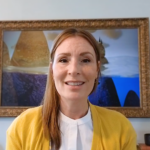April 18, 2024
Why We’re Embracing Acceptance this April—and Beyond

FEATURED POSTS
April 16, 2024
April 15, 2024
As you know, April has been Autism Awareness Month for several decades now. This year, after careful consideration, we are shifting our focus for the month from Autism Awareness to Autism Acceptance. Why Acceptance, instead of Awareness?
For one, leading disability groups nationwide, including the Autism Society of America, Easter Seals, The Arc, and the National Association of Councils on Developmental Disabilities, are shifting to Acceptance—and urging the media and other organizations and outlets to do the same. “The shift in the use of terminology aims to foster acceptance to ignite change through improved support and opportunities in education, employment, accessible housing, affordable health care, and comprehensive long-term services,” the Autism Society release explains.
“While we will always work to spread awareness, words matter as we strive for autistic individuals to live fully in all areas of life,” says Christopher Banks, President and CEO of the Autism Society, in the release. “As many individuals and families affected by autism know, acceptance is often one of the biggest barriers to finding and developing a strong support system.”
Here, Banks echoes feedback from a growing number of individuals with autism—namely, that they have been left out of conversations during Autism Awareness Month and presented as a “problem” that needs to be fixed, instead of as individuals with unique ways of processing and existing in the world. Perhaps Kassiane S., an autistic activist, says it best in her widely circulated essay, “Acceptance vs. Awareness,” written nearly a decade ago, in 2012:
The gulf between awareness and understanding is as wide as any ocean. Awareness is all about creating a sense of urgency and fear. Awareness efforts present us as a problem to be solved, and yesterday. Awareness operates in stereotypes and soundbites, not real people. Awareness has no substance; it is but a tool to earn more money to fix us and to promote yet more awareness.
Awareness is easy. Acceptance requires actual work.
Acceptance comes from a place of understanding. Understanding isn’t generated by soundbites and posterchildren. Understanding takes work. To accept us, people first need to acknowledge us as individuals-as three dimensional, growing, developed characters. We are not all the same, and we are not but a collection of deficits. Acceptance is seeing that — and seeing that one’s distaste for an autistic person is more likely than not because of “autism.” Awareness tells you that anything objectionable about us is “autism,” but that explanation is clear, simple, and wrong.
The discussions around awareness and acceptance are part of the larger debate about ABA and neurodiversity, and whether ABA seeks to rid children and young adults of their core identity—and replace it with a socially-accepted, robot version of personhood. This is in no way reflects the aspirations of LEARN, and we consider it an enormously misguided perception, with potentially dangerous consequences. That said, we do realize the debate about ABA and neurodiversity continues. Across our communities, there are those who believe that any use of ABA is harmful to autistic individuals. We obviously disagree, but at the same time, we understand the historical perspective of ABA treatment as a rigid and structured therapy, which many individuals experienced. For these reasons, we view the criticism as part of a larger voice of concern about the rights of individuals with autism.
We bring this up now, as we embark on Autism Acceptance Month, because we consider our direction taken on the matter an opportunity to respond to the critics of ABA and reaffirm how and why we are an organization dedicated to nurturing, and certainly not harming, every individual with autism in our care. In fact, we design our services in a way that accepts, honors, and fosters individuality.
Throughout April and continuing far beyond, we will share stories and information about our use of contemporary ABA therapy and how we tailor treatment to the unique needs, interests, and values of every child and family in our care. Simultaneously, we will publish and give voice to the thoughts and experiences of a diverse range of people in the autism community, from autistic adolescents and adults to parents, advocates, and leading professionals in the field of autism.
Of course, acceptance cannot happen in a single month. Instead, it will take time and, as Kassiane S. says—hard work. Acceptance, too, is a first step toward the other critical goal: full inclusion.
We hope you will join us in this important endeavor as we work collectively to make a difference in the lives of children and families, and the millions of individuals with autism worldwide.
#togetherwecan
Justin & Hanna
Justin Funches, President, Autism Services, LEARN Behavioral
Hanna Rue, PhD, BCBA-D, Chief Clinical Officer, LEARN Behavioral
LEARN Behavioral specializes in using contemporary applied behavior analysis (ABA) to personalize treatment for children and young adults with autism. With clinical insights refined through decades of service to the autism community, we support more than 5,000 clients across 15 states and the District of Columbia through brands that include AST, BACA, WEAP, BCI, Total Spectrum, Trellis, and SPARKS. Our team consists of more than 30 doctoral-level clinicians, 450 Board Certified Behavior Analysts®, and 4,000 behavior technicians who share a common mission: to find success for every child in our care.






